Exhilarating
Potentials and Frightening Problems.
What are
the new exhilarating potentials and frightening
problems
entailed by the Net's capacity to proliferate hypertextual links between
bundles of disparate data? The Web's "anything instantly" capability --
as the Hypertext guru, Ted Nelson, once put it -- connects not merely information,
but people, and so we have the bracing writerly experience of perpetual
bickering among cybernauts of varying ideologies. Thus media prankster
and cult expert du jour, Richard Metzger, exclaims: "It's
[the web] a total cacophony of disparate voices. . . . But that's a good
thing! More chaos! More ideological Balkanization, please!"[4]
But is diversity of opinion matched by political empowerment and diversity
of access?
A panel
discussion at ISEA '97 held in Chicago recently saw artists who worked
in electronic media addressing this ticklish issue of access, relating
it in their discusssion to the theme of extending multiculturalism within
the electronic art community. Germane here are the insights of Joseph Lockard,
a doctoral candidate at the University of California, Berkeley who
was not represented on the panel, that the ideological complex of individuality
surrounding the discourse about the Net not only erases class, but also
geographic location, gender, race and communal origin.
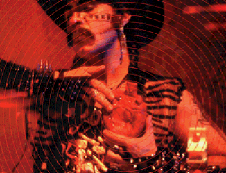
Guillermo
Gómez-Peña
Probing
this point in "The Virtual Barrio @ The Other Frontier,", California performance
artist Guillermo Gómez-Peña cites as his opening epigraph
the following anonymous, class-loaded confession down-loaded from the World-Wide
Web:
"[Mexicans]
are simple people. They are happy with the little they got. . . . They
are not ambitious and complex like us. They don't need all this technology
to communicate. Sometimes I just feel like going down there & living
among them."
In a cautiously
optimistic editorial, Latino digital photographer Pedro Meyer, in his e-zine
ZoneZero,
states that exploitive capitalist formations are propelling the digital
technology into Third World domains. (But he also points out the benefits
those on the margins may obtain in having access to an alternative digital
culture.) He notes that in Third World although some live in the digital
era, the majority ignore its existence willingly or not even as their future
is being profoundly influenced by it. We can't ignore, he writes, the fact
that economic factors control the conceptual basis of photography as well
as how and where it is used. But, he adds,
"Imagine
the difference in a poor neighborhood school teaching students about photography
where traditional film has been replaced with digital cameras whose cost
of film is zero. Not a small issue I would think. Imagine such students
publishing their pictures on the Internet and sharing it with the rest
of the world. That is a real and practical possibility today. Consider
the implications from the point of view of self-esteem for such a youngster.
How will all of this make a difference for a child when he or she grows
up in this new digital era?"
In contradistinction
to Meyer, Lockard would see the concept of "cybercommunity" only as a pseudo-community
geared only toward promoting life-style choices, rather than radical change.
But Lockard does concede somewhat to Meyer's vision. When a community reports
on itself, rather than being the object of mainstream reportage, observes
Lockard, then cyberspace may be the vehicle to unite collective narrative
with collective access. Hence, cyberspace can only gain in effectiveness
and credibility. Certainly, Marshall McLuhan's touting of participational
"cool media" and the evolving "global village," where electricity creates
decentralization was very tantalizing back when first broached in Understanding
Media (1964) and The Medium is the Massage (1967). It is still
given voice in Pedro Meyer's editorial. McLuhan talked about "postliterate
man" living in a world contracted to a village or tribe; there everything
happens to everyone at the same time; everyone knows about, and therefore
participates in everything that is happening the minute it happens. A "cluster
configuration" (hypertextuality) would replace the "linear configuration"
of traditional book literacy. Moreover, in a March 1969 Playboy
interview, he said that: "TV tattoos its message directly on our skins."
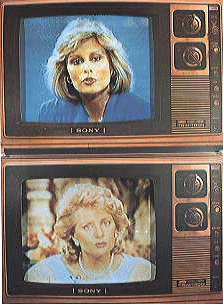
TV Network News Women Corresponding:
Barbara Walter/Faith Daniels
(detail of 8 pieces)
Robert Heincken (1986, cibachrome
Print/
ut back
in 1960, in their introduction to the anthology Exploration in Communication,
McLuhan and co-editor Edmund Carpenter initially expressed a more guarded
opinion of such an evolution in which "this switch from linear to cluster
configuration" impacts literacy as the "main prop" in our social structure
and there becomes "less motivation for the teaching of reading and the
achieving of literature culture." They conclude: "Whether this is good
or bad remains to be seen."[5]This
"good or bad" will not be due to anything inherent in the new electronic
technologies, but due to our lack of mastery of them as "new languages"
in time to "assimilate them to our total cultural heritiage."[6]
Bye-bye
Body.
Like many
academics of my generation, I was also brought up on the clear-cut diatribe
against the mass media by Critical Theory as initially set forth by the
1930s German theorists Walter Benjamin, Theodor Adorno, Max Horkheimer,
and Herbert Marcuse who developed key Marxist theories concerning cultural
production. I also absorbed the technological pessimism of Frenchman Jacques
Ellul's The Technological Society (1954) in which the author opposed
"technique" to nature and claimed the latter's demise; he sorrowed: "It
is an illusion . . . to hope to be able to suppress the 'bad' side of technique
and preserve the 'good'."[7]
So I had an attraction to Ellul's theoretical heir, Jean Baudrillard, for
his touting of 'real life' street activism in opposition to the realm of
the simulacrum, what he termed "hyperreality," in which there was no such
binary as original/copy, only simulations. I was well-prepared to be simpático
with Baudrillard's attack on the media's inherent underlying structure
of domination, what he called the all-pervasive "Code." Yes, even to the
point of agreeing with this Frenchman's pessimism when he claimed that
the media's very form co-opts all negation/resistance, recoups the
most radical content. One learned to, as Australian critic John Docker
put it in his controversial text Postmodernism and Popular Culture:
a Cultural History (1994), "suffer the embrace of communication"
conceived as "fatally attractive, all conquering, smothering."[8]This,
of course, reduced mass cultural texts to a uni-directional mode of communication
that merely shaped the masses' passive ideological subservience to dominant
capitalist values.
More
recently, this pessimism has been updated in Arthur Kroker (editor of CTHEORY)
and Michael Weinstein's Data Trash: the theory of the virtual class
(1994). These authors, influenced by Marx, claim that every technology
releases opposing possibilities towards emancipation and domination. Kroker
and Weinstein focus on the bad aspects of the computer revolution. They
single out "the virtual class" -- a diverse group unified by their technical,
financial, and consumerist support of the new computer technologies on
global capitalism's behalf -- for suppressing the potentially liberating
relations of production released by the Net in favor of the traditionally
predatory force of production signified by the "Infobahn," or "Infosuperhighway."
From Kroker and Weinstein's perspective, a stance they call "crash theory,"
McLuhan's burgeoning media-net, a global nervous system, simply materializes
Catholic theologian Teilhard de Chardin's mystical evolutionary epiphany;
humankind is, according to Chardin, to eventually achieve a state of "ultra-humanity"
as earth's "psychic temperature" dramatically increases. Chardin's global
psychic realm, his "noosphere," has become fact Kroker-Weinstein say. The
convocation of disembodied minds who appear to each other on one of the
Net's BBSs as screenfuls of typed conversation is, as computer-user's rights
activist John Perry Barlow puns, 'the flesh made word'.
Kroker and
Weinstein, in elaborating their "crash theory," mention McLuhan's point that
our consciousness might be trained to respond to the distortions created by
technology and, hence, restore its homeostasis through an intelligent media
diet. The media might yet "serve man." But "crash theory" abandons the notion
that media are true enhancements, "extensions of man." Elaborating upon a
point already broached by McLuhan that "technologies are self-amputations
of our own organs," the authors of Data Trash see the new media as
"humiliations of the flesh." Bring on the ejection seat -- bye-bye body as
it reaches "escape velocity" into the unflesh: "The flesh has crashed and
is in a transition (virtualization) into the media-net to nowhere (to 'cyberspace')."
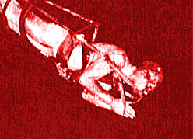

Stelarc in Performance
This, our
telematic being, "circulates and mutates in a cycle in which bodies are uploaded
into, and downloaded from, the media-net, producing a dizzying succession
of hybrid monsters." Interaction and immersion on the Net as participants,
as "hyper-geek incepts," might make us critics IN the Net, but not OF it.
Moreover, resistance to this telematizing of being -- what Kroker and Weinstein
call "inception" -- takes the form of what those authors term "retro-fascism,"
that is, the "brutal quest for purity within the (vanished) flesh" which can
be seen in the proliferation and visibility of White Pride groups on and off
the Net. [9]
Empowerment
or no?
This,
of course, dashes all hopes for using the mass media itself for
any meaningful resistance to society's master discourses of patriarchy,
capitalism, and bourgeois individualism, beliefs re-enforced by the ideological
state apparatuses of family, church, and school. And yet . . . and
yet, part of me wanted to see something liberating in the new technology,
as had Lee Felsenstein and Efrem Lipkin, the founders of Resource One and
Community Memory. These were 1970s' San Francisco Bay area computer resources,
accessible urban data-bases that meant to inform and liberate "The People."
Information was power. Technovisionary Ted Nelson even had once self-published
a "counterculture computer book" titled Computer Lib, its battle
cry being "COMPUTER POWER TO THE PEOPLE!" Unfortunately, this interventionist
vision has been replaced by the likes of Yahoo founder Jerry Yang's pronouncement
cited in The Wall Street Journal ("Oh, the Tangled Web Cybermoguls
Weave," Kara Swisher, Section B-6, March 5, 1998): "It's more fun today
than it was a year ago. The reason is that we are in the position today
to actually help change something, whereas a year ago we were just a very
puny part of something." To which the WSJ reporter observed: "While
Yahoo's menus of Internet sites are terrific, it's not clear that showcasing
all the Web's top Letterman sites will change much of anything."
I thought
of Walter Benjamin's similar ambivalence concerning new technologies.In
"The Work of Art in the Age of Mechanical Reproduction," Benjamin senses
that the new reproductive technologies of photography and film were both
liberating
and
oppressive. Benjamin points to the loss of material
authority, and hence the loss of "aura," entailed by these analog media.
This loss, wrote Benjamin, has empowering and disempowering social potential.
Now in digital technology this loss is absolute, eroding any differentiation
between original and digital copy. Furthermore, electronic communication
on the Net decentralizes the positions of speech and publishing, film-making
and television broadcasting and, with the advent of RealAudio and similar
software, even radio. By extrapolation then, we may assume digital technologies
will exhibit both positive and negative impacts upon society fueling a
vigorous pro and con debate on its efficacy.
British
sociologist Anthony Giddens attempts to see this ambivalence as rooted
in the "mutual dependence of structure and agency." [10]
His "theory of structuration" postulates a mutual dependence between the
individual and society. In Central Problems in Social Theory (1979),
Giddens argues for the "fundamentally recursive character of social life"
which "expresses the mutual dependence of structure and agency." Thus,
all power relations between agent and social structure manifest autonomy
and dependence in both directions. Structure (in our case the new interconnections
generated by the new technology) is both enabling as well as constraining.
Unlike in Baudrillard's thought, structure is not counterposed to freedom.
Moreover, in that central text of postmodernist theory,The
Postmodern Condition: A Report on Knowledge (1979), Jean-Francois Lyotard
notes that people are never completely powerless in relation to communication
or to bureaucracy and the social structure. His well-known championing
of diverse language games, the agon or struggle between competing knowledges,
would seem -- contra Baudrillard -- to be implemented, supported, and extended
by the plethora of new electronic modes of communication (especially the
Internet) becoming available to larger numbers of people. The Internet
and its hypertextual potential would not signal the end of writing, but
it would effect how we perceived author(ity). This is remarked upon by
French Deconstructionist Jacques Derrida in Glyph 1 (1977) even
before the full impact of the computer and the Net was felt: "We are witnessing
not an end of writing that would restore, in accord with McLuhan's ideological
representation, a transparecy or an immediacy to social relations; but
rather an increasingly powerful historical expansion of general writing.
. . . Cut off from all absolute responsibility, from consciousness as the
ultimate authority . . . the intention animating the utterance will never
be through and through present to itself."
And
so we must ask: Just who is getting access to the new media and what use
are they putting it to? What is that media doing to people
who use it? Opposing Derrida's comments above, media theorist and phenomenologist
Michael Heim thinks one doesn't have to delve deeply into the noise-soup
of the Net to get a bitter taste of what he calls the "spew." He admits
that there is "a certain cultural exuberance" about the Net "which is enjoyable,"
but ultimately it's "literacy gone berserk." His solution, however, is
not a neo-Luddite (the original Luddites were nineteenth-century radicals
opposed to machine technology largely for economic reasons), swing-the-hammer,
approach a la media critic Kirkpatrick Sale; it's more akin to Marshall
McLuhan's (Heim's mentor) admonition that we "work
with our freedom within this medium" and "try to adapt it to us and make
it part of our gestures, and not to break away from it and turn our backs
on it." [11]
The Paleocybernetic Age Revisited.
In the 1970s a media theorist and teacher
at California Institute of the Arts, Gene Youngblood, attempted to resolve the
debate over the new media by formulating it in terms of one-directional hierarchy
vs. multipath non-hierarchy, rather than the dichotomy non-electronic
media vs. electronic media. Recall that this was the time of such
art-shakes-hands-with-science programs such as E.A.T. (Experiments in Art and
Technology) which supported artists who were exploring artmaking relation to
computers, video, and lasers.
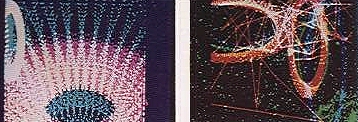
Cybernetik 5.3 (1965-69)
John Stehura, 16mm. color, 8 min.
In Expanded Cinema (1970),
Youngblood describes experiments in these areas, such as John Stehura's
computer-generated film Cybernetik, and called the emerging historical
moment of this exploration "the Paleocybernetic Age" because it combined
the "primitive potential associated with the Paleolithic and the transcendental
integrities of 'practical utopianism' associated with Cybernetic." [12]
He argued that the increasing saturation of the modes of communication
and our correspondent "feeling more comfortable with our [electronic] extensions"
(an obvious debt to McLuhan here) would lead of itself from hegemonic one-way
media communications to more democratic intermedia networks that would
become "metabolically and homeostatically interfaced with each human being."
[13]
But Youngblood seems to have been blind to the reverse scenario, as William
Gibson astutely observes in his classic cyberpunk novel, Neuromancer
(1984), "that burgeoning technologies require outlaw zones . . . a deliberately
unsupervised playground for technology itself." In other words, the world
of hackers and digital artists become unofficial R&D zones for the
new technologies; hence, the willingness of granting agencies, civic and
corporate, to fund artists working within the new technologies, despite
the low aesthetic product that often results.
The Internet, certainly,
would seem to realize Youngblood's utopic vision of intermedia networking.
He enthusiastically viewed the trends toward this shift as "the rebirth
of 'cottage industry' as conceived by the economist William Morris during
the Industrial Revolution in England -- the autonomous ability of the individual
to generate his own industry within his own local environment. The primary
difference," he went on to explain, "between Morris's pre-industrial view
and today's post-industrial reality is that cottage industry and global
cybernetic industrialization interpenetrate each other's spheres of influence
synergetically, each benefiting from the other." [14]
Utopian in outlook, Youngblood here (by fiat) envisioned the conflictual
dichotomies of local vs. global, subjectivity vs. corporatism, rhizomatic
vs. arborescent, as moving toward a mysterious Hegelian overcoming of opposites
via synergy, a total effect that is greater than the mere sum of its parts,
a term popularized by R. Buckminster Fuller who wrote the introduction
to Youngblood's book.
Machines of Loving Grace?
This synthesis of high-tech
with communitarian values is also noted in media critic Theodore Roszak's
discussion of early hacker counterculture's utopian aspirations in The
Cult of Information (1994). He sees guerrilla hackers' vision
of the future as unique in its determination to synthesize these two seemingly
contradictory images: communal life and unabashed technophilia. "Commited
by their tastes and talents to the expansion of high tech," these hackers,
he writes, "had no hesitation in seeking to play through the full repertory
of computer electronics and global telecommunications." However, this "new
technology would be contained within an organic and communitarian political
context," which Roszak refers to as a "hybrid reversionary-technophiliac
vision," and goes on to cite the first stanza of Richard Brautigan's late-1960s
poem "All Watched Over by Machines of Loving Grace" as an exemple of such
an attitude:
I
like to think (and
the
sooner the better!)
of
a cybernetic meadow
where
mammals and computers
live
together in mutually
programming
harmony
like
pure water
touching
clear sky[15]
Roszak sees this curious blend
of return-to-naturism and high-tech as developing out of, and figured by,
the 1960s LSD drug experiences and "acid tests" wherein high-tech chemistry
synthesizes a product capable of taking its users into (supposedly) archetypal,
primitive states of consciousness. Moreover, this primitivizing drug experience
was expressed in the high-tech, hugely amplified psychedelic music of the
time. This reading of the-new-machine-in-the-garden is updated to include
a critique of the "cyber-hippies" of today in Mark Dery's probing
of cybercults and publications like Mondo 2000
in his book Escape
Velocity. Therein, Dery attacks adherents of "cyberdelia" for
their knee-jerk pessimism about political solutions, yet their unbounded
faith in technological ones. He goes on to cite a publisher's catalogue
blurb for Mondo 2000: A User's Guide to the New Edge put it: "Mondo
2000 will introduce you to your tomorrow -- and show you how to buy
it today!"
However, some post-LSD era
squabbles over emerging technology have reintroduced the traditional versus
the new schema once again. A particularly important debate of this ilk,
already broached from the conservative position by Michael Heim in his
book Electric Language (1987), has concerned the efficacy of using
the computer as an instrument for writing and reading; specifically, for
creating multipathed texts that Ted Nelson some two decades ago dubbed
"hypertexts" (McLuhan called them "cluster configurations") which do not
possess the traditional text's tree-like hierarchical-linear structure.
Will such electronic multi-linked texts replace the physical book? Will
this cripple or enhance reading and its effects upon readers? Where McLuhan's
optimism was guarded, and Heim more pessimistic, Nelson is ebullient. Sadie
Plant, eager to see digital technology as rooted in women's traditional
labors, claims such electronic writing as more a species of loom-produced
weaving than traditional writing.
Ride the Rhizome.

"Literature," Nelson wrote in
Literary
Machines (1984) -- extending structuralist concepts broached in the
1920s by the linguists and literary theorists called the Russian Formalists
-- "is an on-going system of interconnecting documents."[16]Similarly,
Michel Foucault, with prescience, wrote prior to the advent of the Net:
"The frontiers of the book are never clear-cut . . . it is caught up in
a system of references to other books, other texts, others sentences: it
is a node within a network." If these two thinkers are correct, hypertext
can be seen as a form of meta-writing, or better, "topographic writing"
(Jay David Bolter)
that is spatially realized as a network, a radicle-system, or "rhizome"
(as Deleuze and Guattari use the term in their tome,
A Thousand
Plateaus, 1987).
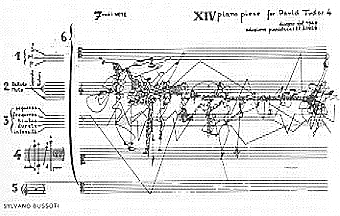
Example of a rhizomatic text
from A Thousand Plateaus (1987)
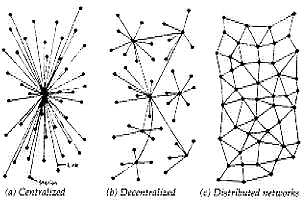
Bolter argues that topographic
writing "challenges the idea that writing should be merely the servant
of spoken language." [17]
One hears echoes of Jacques Derrida's attack on the priorizing of speech,
his lambasting of Western "logocentricity" which claims that speech is
truly able to presence one's thought. Sadie Plant in Zeros + Ones: Digital
Women + the New Technoculture (1997) sees hypertexting as a way to
handle the postmodern condition where enormous amounts of data have "burst
the banks of traditional modes of arranging and retrieving information,"
and as a viable tool for "establishing multiple connections" to better
address the fact that in postmodern academia "no topic is as regular and
simple as was once assumed."
In her recent book Hamlet
on the Holodeck, Janet Murray also constructs a paean to the new electronic
technology. In particular, she focuses on hypertexting in creative writing
and in computer-based educational software. But, curiously, her celebration
is rooted in an anti-Deconstructionist stance: a Humanities teacher
at MIT, she writes about her increasing alienation from postmodern theory
during the 1980s as an opposition between her marriage and child-raising
and "literature and academic feminism" which seemed "somehow to have fallen
into the hands of the suits." She sees the new computer technologies as
a way to garner meaning, rather than disperse it across an intertextual
abyss:
"The
new theoreticians no longer saw the novel as the 'bright book of life'
but as an infinite regression of words about words about words. . . . Truth
and beauty were nowhere in sight. But at the same time that literary theorists
were denouncing meaning as something to be deconstructed into absurdity,
theorists of learning methods were embracing meaning [and using the
computer to do so] as the key to successful pedagogy." [18]
Opposing Bolter -- but akin
to Murray in attacking the full range of postmodernist enthusiasms, such
as the problematizing of stable meaning, the death of the author as the
loss of the unique, conscious intentionality behind the text's production,
and multiculturalism which undermines Western cultural authority -- is
Sven Birkerts' The Gutenberg Elegies (1994). Birkerts predicts a
twilight of the inner, autonomous self as the fate to be suffered by our
"sensibility" in the flattening out of experience in the post-humanist
electronic age where "seductive electronic games have made deep inroads
upon the expanses of dreamy solitude." [19]He
mourns the gradual loss of what real books can do to "augment certain
inner powers," saying that reading "is the intimate,
perhaps secret, part of a larger project, one that finally has little to
do with the more societally oriented conceptions of the individual."[20]
Not merely bemoaning the replacement of images for text in media,
Birkerts even finds subtle differences between old-fashioned texts typed
onto a page and word-processed documents appearing on screen: "The words
are the same, of course. More or less. Yet at some level, perhaps
molecular, they are not the same" [21].
Ultimately,
what Berkerts desires is a retreat to an "ever-present awareness of fixity,
of indelibility" that used to be "so pressing a part of the writer's daily
struggle" which the writing technology today, he says, no longer enforces.
[22]Here
lies the crux of the matter. The Bolter-Birkerts
debate can be seen as a representative example of the extremes -- unbridled
praise of pluralism and difference versus a retour d'ordre to the humanist
stabilities of authority and interior subjectivity -- between which more complex,
"fuzzy" responses to the potential of this technology lie.

A Curtain
on History.
My own
ambivalence concerning the emergent technology remained merely intellectual
for me until I encountered Chicago artist Jno Cook's multi-media gallery
installation and web page "catalogue" titled NO CARRIER in
September 1996 at Beret International Gallery in Chicago. [23]
Therein, I found my own "fuzzy-logical" position on computers physically
embodied in a brilliant ironic hodgepodge of Mason jars filled with doll
heads, linked by tubing, that lampoons scientific experiments, and a "funland"
carousel of out-dated computers working out silly looping and dumb calculations.
This octet of uselessly busy computers reminded me of McLuhan's quip in
Understanding Media (1964) that "all electrical appliances, far
from being labor-saving devices, are new forms of work, decentralized and
made available to everybody." [24]
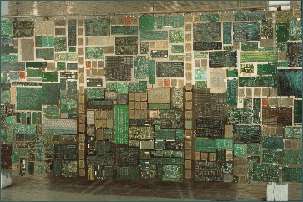
No Carrier, "A Curtain
on History," Jno Cook (1996)
A green
hard-plastic curtain composed of circuit-boards titled "A Curtain on History"
divided the exhibition space; for me it suggested the historical divide
between the industrial and the postindustrial. This sculptural suggestion
of relationship between new electronic technologies and history's theoretically
problematic position today as evoked Marxist critic Fredric Jameson's attack
on postmodernity's "pseudohistorical depth" in which "the history of aesthetic
styles displaces 'real' history." [25]
The piece also recalled the Kroker and Weinstein insight in Data Trash
that history is fast becoming irrelevant as its human subject is no longer
the protagonist of anything but cynical dramas on the media-net. As if
to underscore this latter point, Cook presented enlarged garish color prints
of women's faces, details culled from various Usenet porno repositories.
Is the male gaze being "digitally enhanced" here only to become a reductio
ad absurdum of its desire to objectify?

From No Carrier
(1996) Jno Cook
In Cook's
installation I sensed a kindred, clownish, conflicted spirit. His explanation
of his installation's title inspired the reflective theme, "Art and New
Technology: Pro and Con," of our premier e-zine issue:
"NO
CARRIER represents that moment when you disconnect from net infinity,
and push back your chair to take an overview. It's not really the living
organism it seemed to be. It is only a bunch of machines and telephone
wires. It's not really there, is it?" [26]
A "carnivalesque mode of understanding"
(John Docker's term referring to Russian literary theorist Mikhail Bahktin's
idea of the topsy-turvydom of carnival celebrations as liberatory and challenging
to central authority) seemed to pervade Cook's inversion of Mason jars
with childish things into high-tech looking devices and computers into
mindless, stuttering calculators that beg us to play with them, but who
rebuff our attempts at control. He had taken the sudden juxtapositions,
swift contrasts, and heterogeneity characteristic of the realm of electronic
communications and turned those very qualities back against it.
If I'd written a review of
that show then, my title for it would've been: "Nothing but Nasty Machines
Behaving Nastily in a Nasty Situation." Cook's attitude seems more akin
to Theodore Roszak's as espoused in his recent book The Cult of Information:
A Neo-Luddite Treatise on High-Tech, Artificial Intelligence, and the True
Art of Thinking (1994). Not a doctrinaire technophobe, Roszak admits
to using a word-processor to write his book and to have surfed the Internet
for databases for his research. His main target is the exaggerated claims
for the efficacy of the new technology and its ability to handle information.
I-n-f-o-r-m-a-t-i-o-n -- this vague, cultish "godword," with which this
technology is oft inextricably linked and praised for maximizing, is touted
"by elements in our society that are making some of the most morally questionable
uses of computer power." Such power needs to be challenged "if if the computer
is not to be delivered into the wrong hands." [27]
Roszak
summarizes the history of the term Information Age, envisioning
the new technology as a threat to education and to proper thinking; he
claims it merely adds to the information glut which functions to swamp
us in facts and not in new ideas. Contra the enthusiasms of the likes of
Janet Murray, Rozak is pessimistic concerning the new technology, noting
how "the Information Age" has insidiously and aggressively made its way
into the educational curriculum "which could distort the meaning of thought
itself." He says we often perceive the computer's ability to store information
in vast amounts and process it logically as memory, even as what we call
reasoning in human beings, such that many members of the information cult
"have concluded that what computers do somewhat corresponds to what we
call thinking." [28]
Similarly hostile to AI's reductionist notions intelligence, Sadie Plant
argues in Zeros + Ones that reason and memory is insufficient to
account for intelligence, which in humans combines intuition with irrational
forgetfulness, insight with the ability to dissemble.
Cook's Merry Hacker-Pranksterish
looping computer programs satirize this "cult of information" which Roszak
speaks of, attacking the notion that one can equate computer-processing
with human thought. Roszak observed that, "Measured against that claim,
even the most ingenious computer is bound to look ludicrously inadequate...
more of a joke than an achievement" (my emphasis). [29]
"It's artificial stupidity rather than artificial intelligence," quipped
cyberpunk musician Elliott Sharp. Cook's reconfiguration in NO CARRIER
of computer technology into a hanging curtain and a carousel of computational
mayhem, debunks the illusion that just because computers process data quickly
and microscopically that they don't work like other machines. Cook's installation
is saying: "Hey! computers may look like they're running along as smoothly
and silently as the brain when it remembers and reasons, but . .
." Or, as Roszak points out, "Computers can be taken apart, scrutinized,
and put back together," and they are "low-grade mechanical counterfeits"
for human thinking. [30] For both Cook and
Roszak, the term artificial intelligence is something of an oxymoron.
In
recycling and recontextualizing computer technology, Cook's installation
reminds us, in contemporary art critic Lucy Lippard's words that, "It's
not the medium that counts, and it's not the message that counts, it's
how either or both are presented, in what context, that counts." In the
context of Cook's show, a blatant expropriation of computer technology
from the scientists and the CEOs, this electronic technology is shown to
have the awful potential to create new forms of social obfuscation and
domination, but also the potential to bite the hand that feeds it, to critique
technophilia itself.
So I agree with University
of Illinois, Chicago English professor Joseph Tabbi's point in "Reading,
Writing, Hypertext: Democratic Politics in the Virtual Classroom" that
one should view the Net not as a single medium with a single effect, but
as embedded within the context of other media, including our bodies and
our natural languages. This works, he says, to all the better keep open
the possibilities of reform and dissent within "the newly aggregated digital
media," thus "creating an intermedial balance of powers." [31]
The fate of the Net will depend, he claims, on the ability of its constituencies
to use it critically, and with awareness of each other's existence.










